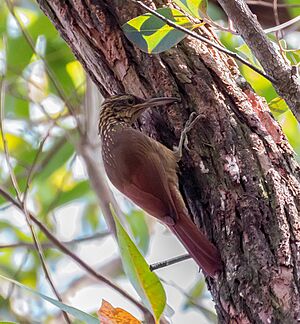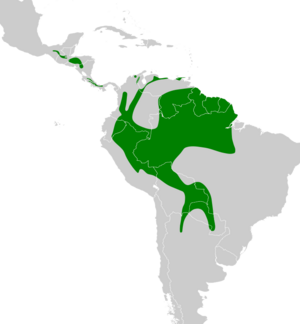Black-banded woodcreeper facts for kids
Quick facts for kids Black-banded woodcreeper |
|
|---|---|
 |
|
| Conservation status | |
| Scientific classification | |
| Genus: |
Dendrocolaptes
|
| Species: |
picumnus
|
 |
|
The black-banded woodcreeper (Dendrocolaptes picumnus) is a cool bird that lives in forests. It's part of the ovenbird family called Furnariidae. This bird is known for its unique way of finding food. You can find it in many places, from Chiapas, Mexico, to Panama. It also lives in almost every country in mainland South America, except for Chile and Uruguay.
Contents
About the Black-banded Woodcreeper Family
Scientists study how different animals are related. For the black-banded woodcreeper, there are some different ideas about its "family tree." Most experts agree there are 10 different types, called subspecies. Think of subspecies as slightly different versions of the same bird. Some scientists group these 10 types into three main groups.
- Spot-throated group
- Black-banded group
- Pale-billed group
There are also ideas that some of these types might even be their own separate species! For example, some experts think D. p. transfasciatus and D. p. pallescens could be separate species. The black-banded woodcreeper's closest relatives are Hoffmanns's woodcreeper and the planalto woodcreeper. Scientists are still learning about how these birds are all connected.
What Does the Black-banded Woodcreeper Look Like?
The black-banded woodcreeper is one of the larger birds in its family. It has a slim body, a long tail, and a straight bill that's not too long. This bird is about 24 to 30.5 centimeters (9.4 to 12.0 inches) long. Males usually weigh between 47 and 89 grams (1.7 to 3.1 ounces). Females are a bit heavier, weighing 48 to 98 grams (1.7 to 3.5 ounces). Both male and female birds look very similar.
Colors and Markings
The most common type, called D. p. picumnus, has a dark face and neck. These areas have light streaks that look buff or tawny. It also has a faint light line above its eye and around it. Its head and back of the neck are dark brown with buffy streaks. The back and wing feathers are olive-brown. The back has thin light streaks and faint dark bars.
Its rump, wings, and tail are a reddish-brown color. The throat is whitish to a deep buff with light streaks. The chest is olive-brown with bold buff streaks. Its belly and sides are buffy brown with strong black bars. The eyes are dark brown. The bill is black, but the lower part might be lighter. Its legs and feet are brown to greenish-gray.
Young Birds and Other Subspecies
Young black-banded woodcreepers look similar to adults. However, they are fluffier. They have bolder streaks and bars on their upper parts. The markings on their underparts are not as strong. Their head is darker and more spotted than streaked.
The other subspecies have slightly different looks. For example, some have a blacker head with fine streaks. Others might have more olive-colored underparts or different colored bills. Some have more spots and fewer streaks on their underparts.
Where Do Black-banded Woodcreepers Live?
The different types of black-banded woodcreepers live in various places.
Spot-throated Group Locations
- D. p. puncticollis: Found in the highlands of Chiapas, Mexico, central Guatemala, Honduras, and north-central Nicaragua.
- D. p. seilerni: Lives in the foothills and highlands of northern Colombia and Venezuela.
- D. p. olivaceus: Found in the eastern foothills of the central Bolivian Andes mountains.
Black-banded Group Locations
- D. p. costaricensis: Lives in the highlands of central and southeastern Costa Rica and western Panama.
- D. p. multistrigatus: Found in the Andes mountains of Colombia and northwestern and western Venezuela.
- D. p. validus: Lives in the western Amazon Basin. This includes parts of Colombia, Ecuador, Peru, Bolivia, and western Brazil.
- D. p. picumnus: Found in the northern Amazon Basin. This includes southern and eastern Venezuela, the Guianas, and northern Brazil.
- D. p. transfasciatus: Lives in the lower Amazon Basin of Brazil.
Pale-billed Group Locations
- D. p. pallescens: Found in the Gran Chaco region of eastern Bolivia, southern Brazil, and western Paraguay.
- D. p. casaresi: Lives in the Andean foothills of northwestern Argentina.
Forest Homes
The black-banded woodcreeper lives in many different kinds of forests. In lowland areas, it prefers "terra firme" forests, which are not flooded. It also lives in forests that flood sometimes. In Mexico and Central America, it likes pine and pine-oak forests. Other places it lives include dry and humid forests, and cloudforests. It mostly stays deep inside old, untouched forests. However, it can also be found at the edges of these forests and in older regrown forests. It rarely lives in tree plantations.
This bird lives at different heights depending on the region. In Mexico, it's found between 1,000 and 3,000 meters (3,300 and 9,800 feet) high. In Central America, it lives from 750 to 2,900 meters (2,460 to 9,510 feet). In Costa Rica and Panama, it's found from 500 to 2,000 meters (1,600 to 6,600 feet). In Colombia and Venezuela, it can be found up to 2,700 meters (8,900 feet). In Peru, it usually stays below 1,300 meters (4,300 feet).
How Black-banded Woodcreepers Behave
Movement
Most black-banded woodcreepers stay in the same area all year long. However, in the northern parts of their range, some might move from higher places to lower places after they have raised their young.
Feeding Habits
The black-banded woodcreeper mainly eats arthropods. These include insects, spiders, scorpions, and centipedes. Sometimes, it also eats small animals like lizards and even frogs. Birds living in the Amazon often follow groups of army ants. They eat the insects and other small creatures that the ants scare out of hiding.
These birds also look for food alone. Sometimes, they join "mixed-species feeding flocks," which are groups of different bird species hunting together. Birds in mountain areas follow ants much less often than those in the lowlands. When following ants, they often perch on a tree trunk or branch close to the ground. From there, they quickly fly out to grab prey from the ground, trunks, branches, leaves, or plants growing on trees. When not following ants, they can look for food at any level of the forest, even high up in the trees.
Breeding and Nests
The time when black-banded woodcreepers nest changes depending on where they live. For example, in Venezuela, they nest in May and June. In Guyana, it's from March to May. In northeastern Brazil, it can include September. They build their nests in holes in trees. These holes can be natural or made by woodpeckers. A female usually lays two eggs. We don't know exactly how long the eggs take to hatch or how long it takes for the young birds to leave the nest. The male and female birds stay together all year. Both parents help to incubate the eggs and care for the baby birds.
What Do They Sound Like?
The black-banded woodcreeper sings mostly at dawn and dusk. It rarely sings during the day. Birds in the Amazon sing a loud series of 15 to 20 fast, clear notes. These notes usually stay at the same pitch, but sometimes they drop at the end. It sounds like "kie-ie-ie--…ie-ee-eu-eu-er" or "glü glü glü glü glü."
Birds in Mexico sing a "high-pitched, descending chatter." In northern Central America, their song is a slow, rolling sound like laughter: "teu-teu-TEU-TEU-TEE-TEE-TEE-TEE-tee-tee-teu-teu-teu." This bird also has many different calls. These include short whines, a nasal "wrenh," a simple "oi" that drops in pitch, and a squealing "squeeh" during fights. They also make a snarling "chauhhh-eesk" sound when alarmed. When competing with other birds, they make a grunting series of "uk-uk-uk" sounds. They also have various rattling calls.
Status and Conservation
The IUCN (International Union for Conservation of Nature) has evaluated the black-banded woodcreeper. They have listed it as a species of "Least Concern." This means that it is not currently in danger of disappearing. The bird lives across a very large area. Scientists estimate there are between 50,000 and 500,000 adult birds. However, this number is thought to be going down. No immediate big threats have been found for this bird.
The black-banded woodcreeper is considered uncommon to fairly common in the Amazon region. It is rarer in the mountainous parts of its range. Some groups of these birds need forests that are mostly untouched. This means they can be very sensitive to human activities that disturb the forest. They might disappear from small pieces of forest. However, their numbers might only drop a little in larger forest areas or in forests where some trees have been cut down.


